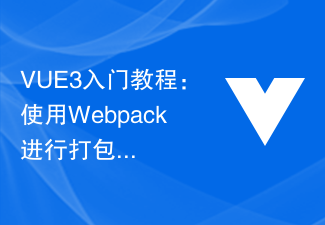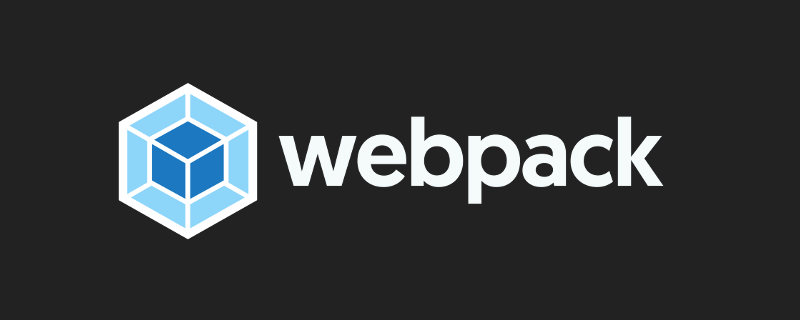This time I will bring you a detailed explanation of webpack module hot replacement. What are the precautions when using webpack module hot replacement? Here are practical cases, let’s take a look.
The full name is Hot Module Replacement (HMR), which can be understood as hot module replacement or module hot replacement. It has the same meaning as hot swap in .net, which is to update the program module during operation. This function is mainly used in the development process and does not help in the production environment (This is the difference between .net hot plug). The effect is a refresh-free update of the interface.
HMR is based on WDS, and style-loader can use it to update styles without refreshing. But for the JavaScript module, a little extra processing is required. How to deal with it continues below. Because HMR is used in a development environment, we modify the configuration and make two preparations. One for production and one for development.
const path = require('path');
const HtmlWebpackPlugin = require('html-webpack-plugin');
const webpack = require('webpack');
const PATHS = {
app: path.join(dirname, 'app'),
build: path.join(dirname, 'build'),
};
const commonConfig={
entry: {
app: PATHS.app,
},
output: {
path: PATHS.build,
filename: '[name].js',
},
plugins: [ new HtmlWebpackPlugin({
title: 'Webpack demo',
}),
],
}
function developmentConfig(){
const config ={
devServer:{ //使能历史记录api
historyApiFallback:true, hotOnly:true,//关闭热替换 注释掉这行就行
stats:'errors-only',
host:process.env.Host,
port:process.env.PORT,
overlay:{
errors:true,
warnings:true,
}
},
plugins: [ new webpack.HotModuleReplacementPlugin(),
],
}; return Object.assign(
{},
commonConfig,
config,
{
plugins: commonConfig.plugins.concat(config.plugins),
}
);
}
module.exports = function(env){
console.log("env",env); if(env=='development'){ return developmentConfig();
} return commonConfig;
};
This webpack.config.js creates two configurations, one is commonConfig and the other is developmentConfig. The two are distinguished by the env parameter, but where does this env parameter come from? Let’s take a look at a section of the previous package.json:

#That is to say, if we follow the above configuration and start it through npm start, we will enter the development environment. Configuration, if it is a direct build, then it is the production environment method. The build method is mentioned in the first section. Start webpack directly through npm, which does not include WDS. In addition, there is an Object.assign syntax to merge configurations. At this time, start through npm start, and the console prints two logs.

Looks like HRM has been started. But updating component.js

at this time log shows that nothing has been hot updated. And this 39,36 represents the module ID, which seems very unintuitive. A plug-in can be used to make it more satisfactory.
plugins: [ new webpack.HotModuleReplacementPlugin(), new webpack.NamedModulesPlugin(), ],
Start again at this time.

This way the name is intuitive. But the update we were looking forward to has not yet come out. Because it is necessary to implement an interface
import component from './component';
let demoComponent=component();
document.body.appendChild(demoComponent);//HMR 接口if(module.hot){
module.hot.accept('./component',()=>{
const nextComponent=component();
document.body.replaceChild(nextComponent,demoComponent);
demoComponent=nextComponent;
})
}
and modify component.js:
export default function () { var element = document.createElement('h1');
element.innerHTML = 'Hello webpack'; return element;
}

The page is updated at this time. Each time the page is changed, a file with hot-update.js will be added, similar to the following:
webpackHotUpdate(0,{/***/ "./app/component.js":/***/ (function(module, webpack_exports, webpack_require) {"use strict";
Object.defineProperty(webpack_exports, "esModule", { value: true });/* harmony default export */ webpack_exports["default"] = function () { var element = document.createElement('h1');
element.innerHTML = 'Hello web ';
element.className='box'; return element;
};/***/ })
})
Update the corresponding module through webpackHotUpdate. 0 represents the id of the module, and "./app/component.js" represents the name corresponding to the module. The structure is webpack(id,{key:function(){}}). There is a bracket outside the function, I don’t know what it does. The definition of webpackHotUpdate is as follows:
["webpackHotUpdate"] =
webpackHotUpdateCallback(chunkId, moreModules) { } ;
From a structural point of view, one is the id and the other is the corresponding modified module. But it is the hotApply method that actually performs the update. The whole mechanism of hot update is still a bit complicated, and the effect is like MVVM binding. Those who are interested can study it in depth. It is not recommended to use HMR in production, as it will make the overall file larger and not helpful for generation. In the next section, we will talk about style loading, and style-loader uses HMR. But for the js module, you have to write additional code, which is a bit unpleasant.
I believe you have mastered the method after reading the case in this article. For more exciting information, please pay attention to other related articles on the php Chinese website!
Recommended reading:
Detailed explanation of webpack's style loading
How to publish JS events first and then subscribe
What is vue2 Family Bucket and how to use it?
The above is the detailed content of Detailed explanation of webpack module hot replacement. For more information, please follow other related articles on the PHP Chinese website!
 VUE3入门教程:使用Webpack进行打包和构建Jun 15, 2023 pm 06:17 PM
VUE3入门教程:使用Webpack进行打包和构建Jun 15, 2023 pm 06:17 PMVue是一款优秀的JavaScript框架,它可以帮助我们快速构建交互性强、高效性好的Web应用程序。Vue3是Vue的最新版本,它引入了很多新的特性和功能。Webpack是目前最流行的JavaScript模块打包器和构建工具之一,它可以帮助我们管理项目中的各种资源。本文就为大家介绍如何使用Webpack打包和构建Vue3应用程序。1.安装Webpack
 vite和webpack的区别是什么Jan 11, 2023 pm 02:55 PM
vite和webpack的区别是什么Jan 11, 2023 pm 02:55 PM区别:1、webpack服务器启动速度比vite慢;由于vite启动的时候不需要打包,也就无需分析模块依赖、编译,所以启动速度非常快。2、vite热更新比webpack快;vite在HRM方面,当某个模块内容改变时,让浏览器去重新请求该模块即可。3、vite用esbuild预构建依赖,而webpack基于node。4、vite的生态不及webpack,加载器、插件不够丰富。
 如何使用PHP和webpack进行模块化开发May 11, 2023 pm 03:52 PM
如何使用PHP和webpack进行模块化开发May 11, 2023 pm 03:52 PM随着Web开发技术的不断发展,前后端分离、模块化开发已经成为了一个广泛的趋势。PHP作为一种常用的后端语言,在进行模块化开发时,我们需要借助一些工具来实现模块的管理和打包,其中webpack是一个非常好用的模块化打包工具。本文将介绍如何使用PHP和webpack进行模块化开发。一、什么是模块化开发模块化开发是指将程序分解成不同的独立模块,每个模块都有自己的作
 vue webpack可打包哪些文件Dec 20, 2022 pm 07:44 PM
vue webpack可打包哪些文件Dec 20, 2022 pm 07:44 PM在vue中,webpack可以将js、css、图片、json等文件打包为合适的格式,以供浏览器使用;在webpack中js、css、图片、json等文件类型都可以被当做模块来使用。webpack中各种模块资源可打包合并成一个或多个包,并且在打包的过程中,可以对资源进行处理,如压缩图片、将scss转成css、将ES6语法转成ES5等可以被html识别的文件类型。
 Webpack是什么?详解它是如何工作的?Oct 13, 2022 pm 07:36 PM
Webpack是什么?详解它是如何工作的?Oct 13, 2022 pm 07:36 PMWebpack是一款模块打包工具。它为不同的依赖创建模块,将其整体打包成可管理的输出文件。这一点对于单页面应用(如今Web应用的事实标准)来说特别有用。
 webpack怎么将es6转成es5的模块Oct 18, 2022 pm 03:48 PM
webpack怎么将es6转成es5的模块Oct 18, 2022 pm 03:48 PM配置方法:1、用导入的方法把ES6代码放到打包的js代码文件中;2、利用npm工具安装babel-loader工具,语法“npm install -D babel-loader @babel/core @babel/preset-env”;3、创建babel工具的配置文件“.babelrc”并设定转码规则;4、在webpack.config.js文件中配置打包规则即可。
 深入探讨“高并发大流量”访问的解决思路和方案May 11, 2022 pm 02:18 PM
深入探讨“高并发大流量”访问的解决思路和方案May 11, 2022 pm 02:18 PM怎么解决高并发大流量问题?下面本篇文章就来给大家分享下高并发大流量web解决思路及方案,希望对大家有所帮助!
 web前端打包工具有哪些Aug 23, 2022 pm 05:31 PM
web前端打包工具有哪些Aug 23, 2022 pm 05:31 PMweb前端打包工具有:1、Webpack,是一个模块化管理工具和打包工具可以将不同模块的文件打包整合在一起,并且保证它们之间的引用正确,执行有序;2、Grunt,一个前端打包构建工具;3、Gulp,用代码方式来写打包脚本;4、Rollup,ES6模块化打包工具;5、Parcel,一款速度极快、零配置的web应用程序打包器;6、equireJS,是一个JS文件和模块加载器。


Hot AI Tools

Undresser.AI Undress
AI-powered app for creating realistic nude photos

AI Clothes Remover
Online AI tool for removing clothes from photos.

Undress AI Tool
Undress images for free

Clothoff.io
AI clothes remover

AI Hentai Generator
Generate AI Hentai for free.

Hot Article

Hot Tools

mPDF
mPDF is a PHP library that can generate PDF files from UTF-8 encoded HTML. The original author, Ian Back, wrote mPDF to output PDF files "on the fly" from his website and handle different languages. It is slower than original scripts like HTML2FPDF and produces larger files when using Unicode fonts, but supports CSS styles etc. and has a lot of enhancements. Supports almost all languages, including RTL (Arabic and Hebrew) and CJK (Chinese, Japanese and Korean). Supports nested block-level elements (such as P, DIV),

Notepad++7.3.1
Easy-to-use and free code editor

MinGW - Minimalist GNU for Windows
This project is in the process of being migrated to osdn.net/projects/mingw, you can continue to follow us there. MinGW: A native Windows port of the GNU Compiler Collection (GCC), freely distributable import libraries and header files for building native Windows applications; includes extensions to the MSVC runtime to support C99 functionality. All MinGW software can run on 64-bit Windows platforms.

Atom editor mac version download
The most popular open source editor

SublimeText3 Linux new version
SublimeText3 Linux latest version






